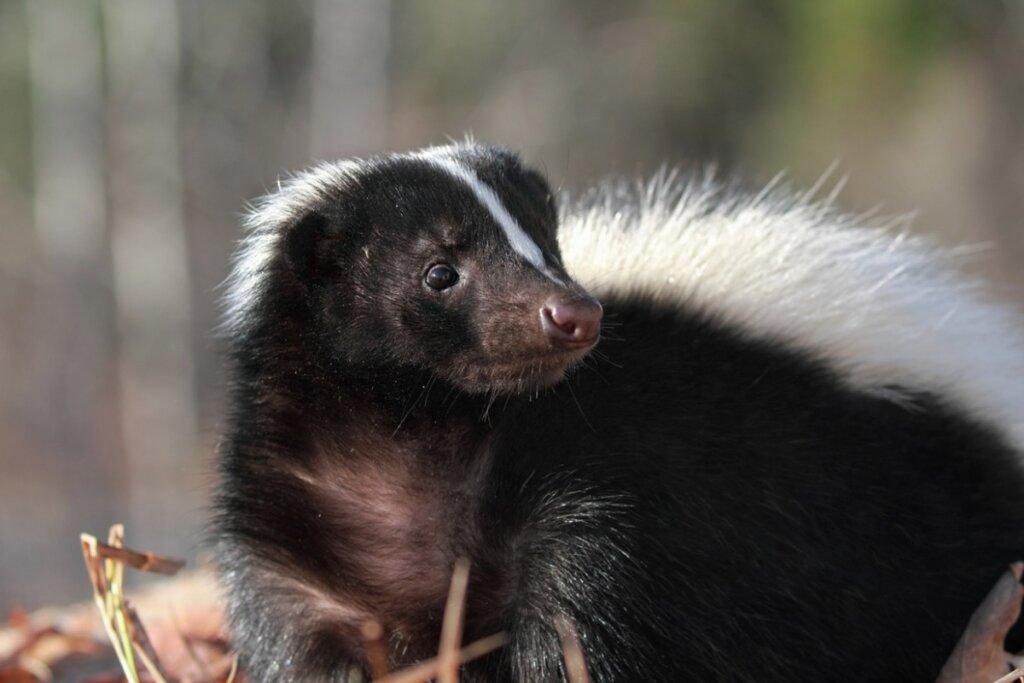7 Curiosities About Skunks

You most likely associate the skunk with the foul odor it can secrete when it feels in danger, but there are many other curiosities about skunks that will amaze you. These mammals, so hated for this smelly characteristic, are actually peaceful beings that rarely get into trouble, especially with humans.
In this article, you’ll find curious facts about them and their biological makeup. Don’t miss it!
7 curiosities about skunks
Skunks belong to the genus Mephitis and are native to North and Central America. They’re characterized by the black and white pattern on their fur and their long tail. Let’s learn some interesting facts about them.
1. There are only two species in their genus
There are currently 2 species of skunks recognized within the genus Mephitis: the striped skunk (Mephitis mephitis) and the hooded skunk (Mephitis macroura). While the former is the best known, with its pattern of stripes running along its back, the latter’s entire upper body is white.
2. The skunk’s stripes point to the gland that sprays
This is one of the curiosities about skunks that not many people know about. The white stripes that run down its back end just where the glands that produce the foul-smelling liquid are located.
This is an adaptation that serves as an intimidating method. When the skunk is cornered and has to face its threat, it will display its anal area as a warning. It’s always better to scare than to fight.
3. They also make warning movements
The predator may not know what a skunk is capable of and may not understand the significance of this particular color pattern. So, what skunks do is perform a series of movements, similar to a warning dance, in which they stomp the ground, wag their tails, and raise their paws.
4. Thiol, the molecule that gives the skunk its bad smell
As you probably already know, the skunk’s bad smell is part of its defense mechanism against predators. It’s a liquid called thiol, which is secreted in the animal’s perianal glands. Its smell, somewhere between bitter and rotten, is due to its sulfur content.
Thiol can be irritating to the skin and eyes (if you’re unlucky enough to get it in your face). However, it’s not a toxic substance, at least to large animals, such as humans.
5. They can shoot their liquid up to 3 meters (nearly 10 feet)
This method of defense is radical: when it has no choice, the skunk will aim at its aggressor and shoot a jet of the foul-smelling substance. The goal is to escape, so it has to be able to shoot it over a long distance in order to have a chance of escaping.
One of the curiosities about skunks in this respect is that it’s actually the animal’s last resort. After each discharge, it needs to recharge its glands, which can take several days. During that period it will be unprotected, so you would have to put it in serious danger for it to shoot at you.
6. They sometimes leave their scent near humans
It is common for skunks to approach human homes and areas in search of food. Sometimes this involves them marking car wheels, corners, garbage cans, and other objects with their scent. However, there are homemade formulas that eliminate the odor with no problem:
- The mixture of tomato juice and vinegar is useful to eliminate odors, but if you need to get rid of stinging skin or eyes, this isn’t a valid method.
- Mixing baking soda, liquid soap, and hydrogen peroxide is a good solution for clothes and hair. Be careful that the mixture doesn’t come into contact with eyes or mucous membranes, and don’t prepare it in advance for storage – the container could explode due to gas accumulation.
- Diluted vinegar, or other vinegar solutions that are marketed for cleaning objects or clothes, are very effective to eliminate strong odors in general.
7. They’re totally harmless
This is the last of our curiosities about skunks, but not the least important. Many people are frightened of them or fear that they will leave their scent nearby, and therefore resort to aggressive behavior. So, remember that all they want to do is eat and they would never approach us if it weren’t absolutely necessary.
This planet isn’t ours alone, despite the fact that we’re the dominant species. The least we can do, when other animals approach our territories, is to try to avoid a conflict. Especially when we both lose out, as in the case of skunks!
All cited sources were thoroughly reviewed by our team to ensure their quality, reliability, currency, and validity. The bibliography of this article was considered reliable and of academic or scientific accuracy.
- Wood, W. F., Sollers, B. G., Dragoo, G. A., & Dragoo, J. W. (2002). Volatile components in defensive spray of the hooded skunk, Mephitis macroura. Journal of chemical ecology, 28(9), 1865-1870.
- Mephitis mephitis (striped skunk). (s. f.). Animal Diversity Web. Recuperado 20 de octubre de 2022, de https://animaldiversity.org/accounts/Mephitis_mephitis/
- Stankowich, T., Caro, T., & Cox, M. (2011). Bold coloration and the evolution of aposematism in terrestrial carnivores. Evolution: International Journal of Organic Evolution, 65(11), 3090-3099.
